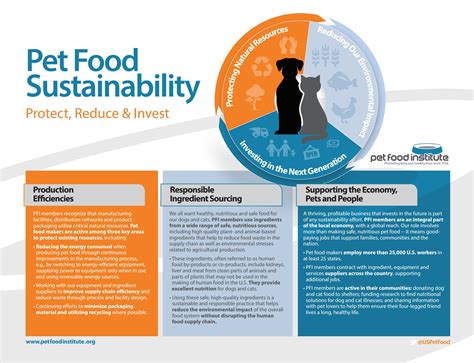The Growing Demand for Pet Food: A Challenge for Sustainability
In 2023, the global pet food market was valued at around $120 billion. By 2025, it is expected to reach $142 billion. This increase in demand is driven by the growing number of pet owners worldwide. In the US alone, there are over 90 million pet owners, who spend an average of $1,200 per year on their pet’s food.

This growing demand for pet food is putting a strain on the environment. The production of pet food requires large amounts of land, water, and energy. In addition, the processing and packaging of pet food can generate greenhouse gases.
Sustainable Agriculture: A Solution for the Pet Food Industry
Sustainable agriculture is a set of practices that protect the environment while producing food. Sustainable agriculture practices can be used to grow crops for pet food, raise animals for pet food, and process and package pet food.
Some of the benefits of sustainable agriculture include:
- Reduced environmental impact
- Improved animal welfare
- Increased profitability
How Pet Food Companies Can Adopt Sustainable Agriculture
Pet food companies can adopt sustainable agriculture practices in a number of ways. Some of the most common ways include:
- Sourcing ingredients from sustainable farms: Pet food companies can work with farmers who use sustainable practices to grow crops and raise animals.
- Using eco-friendly packaging: Pet food companies can use packaging materials that are recycled, biodegradable, or compostable.
- Reducing energy consumption: Pet food companies can invest in energy-efficient equipment and processes.
The Future of Pet Food: A Sustainable Vision
By 2025, the pet food industry is expected to be more sustainable than ever before. Pet food companies will be using sustainable agriculture practices to reduce their environmental impact and improve animal welfare. Consumers will be more aware of the importance of sustainable pet food, and they will be willing to pay a premium for products that are made in a sustainable way.
FAQs: Pet Food and Sustainable Agriculture
1. What is the environmental impact of pet food production?
The production of pet food requires large amounts of land, water, and energy. In addition, the processing and packaging of pet food can generate greenhouse gases.
2. What are the benefits of sustainable pet food?
Sustainable pet food is produced using practices that protect the environment, improve animal welfare, and increase profitability.
3. How can pet food companies adopt sustainable agriculture?
Pet food companies can adopt sustainable agriculture practices by sourcing ingredients from sustainable farms, using eco-friendly packaging, and reducing energy consumption.
4. What is the future of pet food?
The future of pet food is sustainable. By 2025, the pet food industry is expected to be more sustainable than ever before. Pet food companies will be using sustainable agriculture practices to reduce their environmental impact and improve animal welfare. Consumers will be more aware of the importance of sustainable pet food, and they will be willing to pay a premium for products that are made in a sustainable way.
Reviews: Pet Food and Sustainable Agriculture
1. “Pet Food and Sustainable Agriculture: A Comprehensive Guide” by the American Pet Products Association
This guide provides a comprehensive overview of the environmental impact of pet food production and the benefits of sustainable pet food. It also includes a directory of pet food companies that are using sustainable practices.
2. “The Sustainable Pet Food Handbook” by the Humane Society of the United States
This handbook provides pet owners with information on how to make sustainable choices about their pet’s food. It includes tips on choosing sustainable pet food, reducing food waste, and recycling pet food packaging.
3. “Pet Food and Sustainability: A Report from the World Wildlife Fund”
This report provides a detailed analysis of the environmental impact of pet food production. It also includes recommendations for pet food companies and consumers on how to reduce their environmental impact.
4. “The Future of Pet Food: A Sustainable Vision” by the Pet Food Institute
This report provides a vision for the future of the pet food industry. It outlines the key trends that are driving the demand for sustainable pet food and provides recommendations for pet food companies on how to meet this demand.
Market Insights: Pet Food and Sustainable Agriculture
The global pet food market is expected to grow by 5.6% annually over the next five years.
The demand for sustainable pet food is growing rapidly.
Pet food companies are investing in sustainable agriculture practices.
Consumers are willing to pay a premium for sustainable pet food.
The pet food industry is at a crossroads. The demand for pet food is growing, but the environmental impact of pet food production is a concern. Sustainable agriculture provides a solution to this challenge. By adopting sustainable agriculture practices, pet food companies can reduce their environmental impact, improve animal welfare, and increase profitability.





















